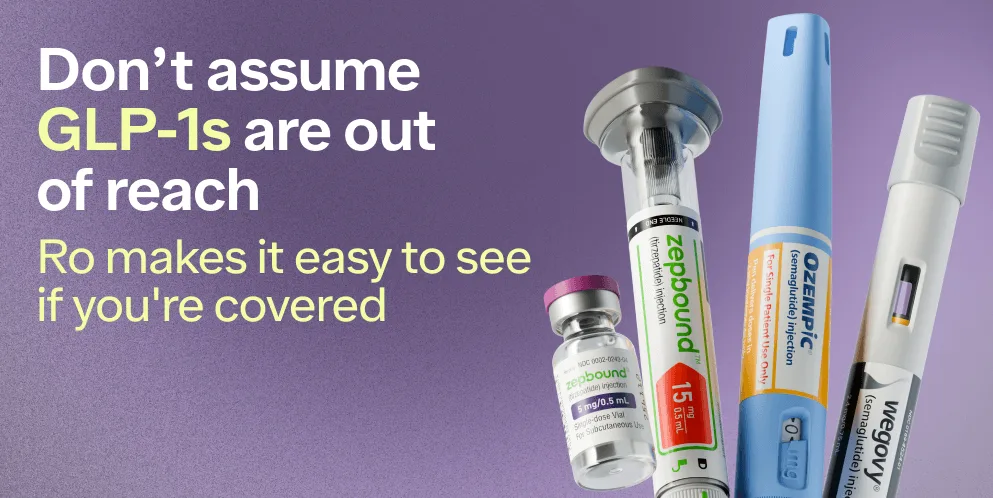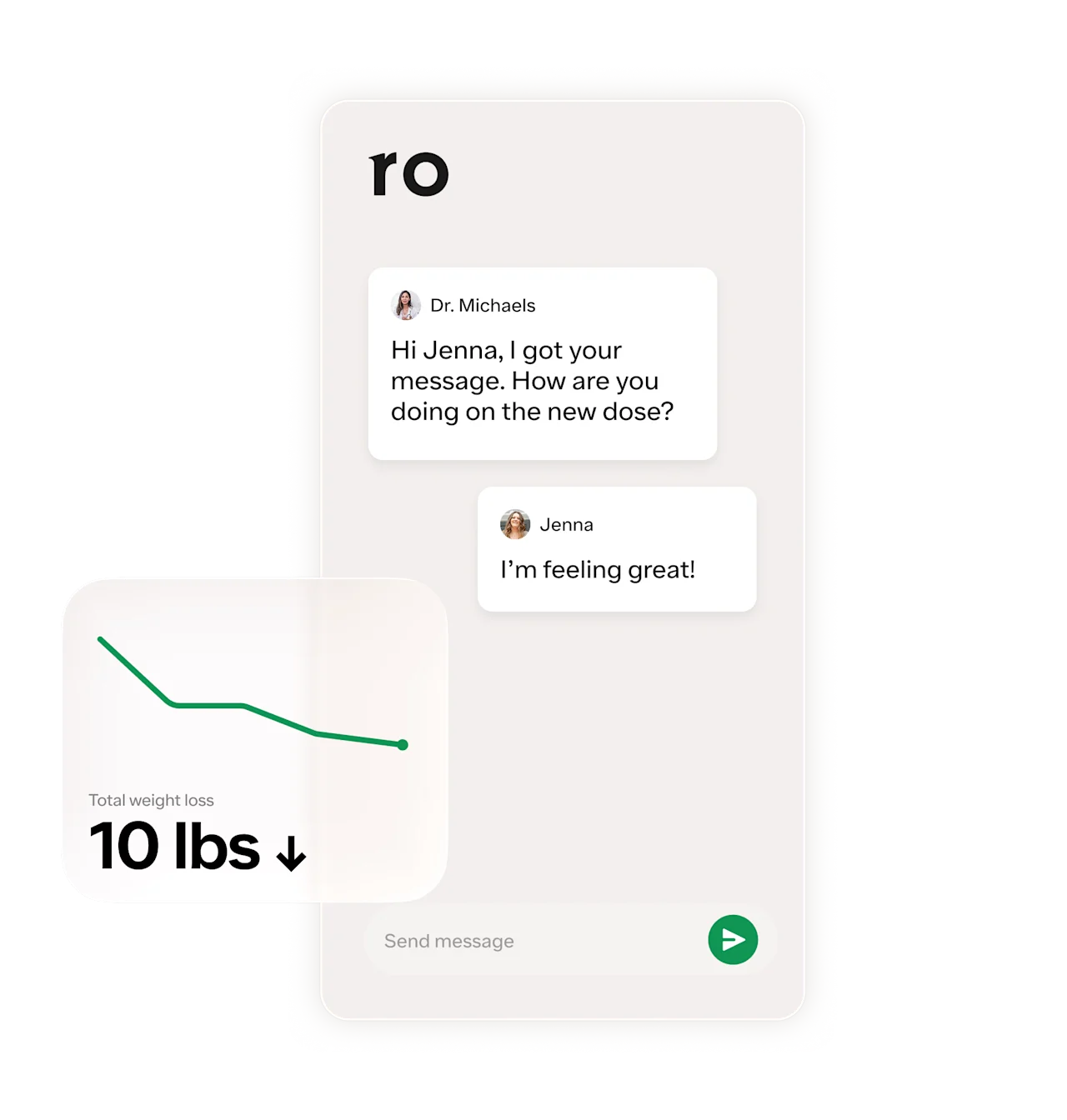Here's what we'll cover
Here's what we'll cover
Here's what we'll cover
Ozempic, one of a class of medications that can be used to treat diabetes and help with weight loss, is available by prescription only from a licensed medical professional. If you’ve been trying to lose weight, but diet and exercise alone aren’t enough, your health provider may recommend a medication like Ozempic.
Wondering if you might be eligible for this medication and how the process works? Read on. We explain what you need to know about getting Ozempic for weight loss.
Ozempic Important Safety Information: Read more about serious warnings and safety info.
What is Ozempic?
Ozempic (semaglutide) is a once-weekly injectable medication that is FDA-approved to help people with type 2 diabetes control their blood sugar levels, and, in people who have both type 2 diabetes and heart disease, reduce the risk of a cardiovascular event like heart attack or stroke. Semaglutide, the active ingredient in Ozempic, has also been shown to be effective for weight loss. In addition to the FDA-approved indications for using the medication, healthcare providers may prescribe Ozempic off-label to help patients who have been struggling to lose weight to do so and keep it off.
In fact, Novo Nordisk, the makers of Ozempic, sells another medication that contains a higher dosage of the same active ingredient––semaglutide––and was developed specifically for weight management in people with obesity and overweight. It goes by the brand name Wegovy and also requires a prescription.
How much weight do people lose on Ozempic?
People without diabetes may lose around 8% to 12% of their body weight in one year when taking 1 mg or 2 mg weekly doses of semaglutide, a common dosage for Ozempic. People without diabetes may lose around 11% of their body weight in five months when taking semaglutide 2.4 mg weekly, a common dosage of Wegovy. This number may not hold true for everyone, though: research has found that people with type 2 diabetes tend to experience less weight loss on GLP-1 medications like Ozempic than those who don’t have diabetes.
Still, these medications do produce significantly more weight loss than diet and exercise alone. In one study comparing semaglutide vs. a placebo, those who took the placebo lost less than 4% of their body weight during a longer time period. Whether you are taking Ozempic to manage type 2 diabetes, weight, or both, it is important to remember that the medication is most effective when combined with lifestyle changes like diet and exercise.
Ozempic is injected subcutaneously (under the skin) of the thigh, abdomen, or upper arm on a weekly basis. Each Ozempic pen contains several doses of the medication, so you’ll need to keep it refrigerated or at room temperature between uses (Ozempic should always be refrigerated before its first use). When you first start taking Ozempic, your health provider will slowly titrate your dose over several weeks, to help your body get used to the medication and to minimize side effects. The starting dose of Ozempic is 0.25 mg weekly. It can take 12–16 weeks to reach your maintenance dose of 1 mg or 2 mg.
During those initial months of taking the medication, you may be more likely to experience Ozempic’s side effects, which can include:
Vomiting
Diarrhea
Abdominal pain
Constipation
Upset stomach or indigestion
Belching
Flatulence
Gastroesophageal reflux disease (GERD)
Nausea, vomiting, and diarrhea are the most common side effects of Ozempic. They are more common at the beginning, but tend to go away with time as your body gets used to the medication.
Can you get Ozempic without diabetes?
Yes, you can get Ozempic without diabetes, although it would technically be an off-label prescription. Off-label prescribing allows healthcare providers to use their discretion in prescribing the best medication for their patients, even if it’s for a different condition than what the FDA has approved the drug for. Prescribing Ozempic for weight loss is considered off-label, since it’s not FDA-approved for weight loss specifically. It’s worth noting that off-label prescriptions are less likely to be covered by insurance.
How to get Ozempic for weight loss
Ozempic is a prescription medication, so you’ll need to meet with a licensed healthcare professional, either online or in person, to get It for weight loss.
Do you need a prescription for Ozempic?
Yes, you need a prescription for Ozempic. Like most prescription medications, you can’t bypass a visit to the doctor. To get Ozempic, you’ll need a valid prescription from a healthcare provider. The good news is this can be obtained either through an in-person visit with your doctor or via a licensed telehealth provider, who can assess your needs and prescribe Ozempic if it’s appropriate for you from the comfort of your home.
How to get Ozempic from your doctor
Start your appointment by sharing your symptoms, personal and family medical history, and a list of all the medications and supplements you are currently taking. Tell your provider about your experience trying to lose weight through diet, exercise, or other interventions. Understanding how your body has responded to weight loss efforts can help your provider determine whether Ozempic is a good treatment option for you, or if another medication or weight loss approach could be more effective.
Your health provider will also want to know your full medical history and any medications you’re taking. This helps them determine if Ozempic is a safe option for you, and prevent potential interactions you could experience while taking Ozempic. Ozempic should not be used by people who are pregnant or trying to become pregnant, or those with certain medical conditions, including pancreatitis, a history of medullary thyroid carcinoma, or those with multiple endocrine neoplasia syndrome type 2 (MEN2).
Also, Ozempic slows down digestion, which can affect the absorption of any oral medications you are taking. Your doctor may adjust your dosage or the dosage of any medications or supplements you are taking or recommend an alternative. They could also suggest a different weight loss medication altogether. People who use insulin, for instance, will likely need to adjust their dosage of insulin in order to avoid experiencing hypoglycemia (low blood sugar) while using Ozempic.
Once you have your prescription, you can fill it at your local pharmacy or through an online pharmacy.
How to get Ozempic online
Alternatively, you can use an online weight loss program such as the one through Ro. This comprehensive program includes a personalized treatment plan (with a prescription for a GLP-1 medication like Ozempic), a one-on-one dedicated health coach, ongoing support and resources for weight loss.
It all starts with an online appointment with a licensed health provider. After reviewing your medical history, your healthcare provider may order a metabolic lab test for you to complete. Then, Ro’s insurance concierge will work with your insurance to help get the cost of your GLP-1 medication covered if prescribed.
Once you have your prescription, you can fill it at your local pharmacy or through an online pharmacy.
Who qualifies for Ozempic for weight loss?
If you are hoping to get Ozempic for weight loss, but don’t have type 2 diabetes, your healthcare provider may use your body mass index (BMI) to see if you qualify for Ozempic. BMI is by no means a perfect measure when it comes to determining obesity (it doesn’t account for muscle mass, ethnicity, age, or sex), it’s still the tool healthcare providers use because it’s quick and easy to calculate. All healthcare providers need to calculate your BMI is your current body weight and height.
BMI is also the same measurement used to determine if people qualify to take Wegovy for weight loss, an alternative medication that contains the same active ingredient as Ozempic, but in higher dosage strengths. Specifically, the FDA has approved Wegovy for weight loss in people with:
Obesity (measured as a BMI of 30 or greater); or
Overweight (measured as a BMI of 27 or higher) with at least one weight-related health condition, such as high blood pressure or cholesterol
If your BMI falls into one of the above ranges, your healthcare provider may choose to prescribe Ozempic for weight loss.
Who shouldn’t take Ozempic for weight loss?
For some people, Ozempic may not be the best option for weight loss. If you have certain health conditions or are taking certain medications, Ozempic may not be safe for you to take. Specifically, Ozempic is not recommended for anyone with a personal or family history of thyroid cancers, including medullary thyroid carcinoma (MTC) or multiple endocrine neoplasia syndrome type 2 (MEN 2). People with a known allergy to semaglutide, the active ingredient in Ozempic, should also avoid taking Ozempic.
People with a history of pancreatitis, diabetic retinopathy, or kidney or gallbladder problems may be more likely to experience serious side effects when taking Ozempic. Talk to your healthcare provider about your options if any of the above applies to you.
If you are taking insulin, your healthcare provider may need to adjust your dosage to prevent you from experiencing hypoglycemia while taking Ozempic. Also, while Ozempic is not known to have any negative drug interactions, it can affect the absorption of any oral medications you take, since it slows down digestion. Again, talk with your healthcare provider about your options here.
How to get insurance coverage for Ozempic
Insurance plans are generally more likely to cover medications for their FDA-approved condition. In other words, your plan may be more likely to cover Ozempic if it’s being prescribed to treat type 2 diabetes, but not obesity.
To check if your plan includes prescription drug coverage for Ozempic, review your policy online or read over the paper copy you received in the mail. You can also call your insurance company directly to see if Ozempic is covered.
Even if your plan covers Ozempic for type 2 diabetes, using it for weight loss is considered off-label and will require prior authorization. Your healthcare provider can submit a form requesting coverage on your behalf, but coverage is not guaranteed. Your health insurance plan may require you to meet the same eligibility criteria that are used to qualify people for GLP-1 medications that are FDA-approved specifically for weight loss, like Wegovy. Wegovy is FDA-approved to treat people with:
Obesity, defined as a BMI of 30 or higher
Overweight, defined as a BMI of 27 or higher, and a weight-related health condition like diabetes, high blood pressure, or high cholesterol
Heart disease and obesity or overweight, to reduce the risk of major cardiovascular problems like stroke and heart attack
You may need to fall into one of these categories before your plan will approve coverage for Ozempic (or Wegovy). If you are prescribed Ozempic through Ro's weight loss program, Ro’s insurance concierge will verify your benefits and work with your insurer to get Ozempic covered for weight loss. The process typically takes 2–3 weeks.
How much is Ozempic without insurance?
Without insurance, a one-month supply of Ozempic costs $968.52, on average. However, the price of Ozempic can vary from pharmacy to pharmacy. To save on Ozempic, try calling several local pharmacies to see which offers the lowest price. You may also want to ask about how much a longer two- or three-month supply costs. Sometimes larger refills can be more cost-effective.
If your insurance provider offers coverage for Ozempic, the price you’ll pay for your prescription will be lower. However, if you have insurance, but your plan doesn’t cover Ozempic, you still may be able to save. The Ozempic Savings Card can bring the cost of Ozempic down to as little as $25 per refill. To be eligible, you must have private or commercial insurance and be a U.S. citizen with a valid prescription for Ozempic.
Novo Nordisk also manages a Patient Assistant Program, or PAP, for people with diabetes who have trouble affording their Ozempic prescription. The PAP provides Ozempic for free to people who have a total household income at or below 400% of the federal poverty level. You can have Medicare coverage, but you must not have any other insurance coverage either through a private, federal, state, or government program, including Medicaid or Veterans Affairs (VA) benefits.
Ozempic alternatives
Ozempic is one of several GLP-1 medications that may be prescribed for type 2 diabetes or weight loss. If your insurance plan doesn’t cover Ozempic, ask your healthcare provider if one of these Ozempic alternatives could be a safe and effective option for you instead.
Wegovy
Wegovy (semaglutide) contains the same active ingredient as Ozempic, semaglutide. However, it is available in a higher 2.4 mg dosage and is FDA-approved specifically for weight loss. Wegovy is also FDA-approved to reduce the risk of major cardiovascular events (like stroke, heart attack, and death) in people with heart disease and obesity or overweight.
People using Wegovy 2.4 mg tend to lose more weight than those on Ozempic 1 mg — 27.5 pounds vs. 8.2 pounds in one year, for example.
However, some side effects are also more common with Wegovy, including nausea, vomiting, and diarrhea. When compared to Ozempic, Wegovy also has a longer list of side effects in general. For example, other common Wegovy side effects can include dizziness, headache, fatigue, belching, and flatulence, for example.
Wegovy Important Safety Information: Read more about serious warnings and safety info.
Saxenda
Saxenda (liraglutide) is another GLP-1 medication FDA-approved specifically for weight loss, in people with obesity (BMI of 30 or greater) or overweight (BMI of 27 or greater).
People taking the highest dosage of Saxenda (3 mg) lose more weight than those on Ozempic 1 mg, around 11.5 pounds per year, but less than those taking Wegovy 2.4 mg.
Saxenda produces similar gastrointestinal side effects to Ozempic, including nausea, diarrhea, and constipation. However, it also produces additional side effects such as headache, fatigue, increased lipase, and fever. Another big difference between Saxenda and Ozempic is that Saxenda is injected daily.
Saxenda Important Safety Information: Read more about serious warnings and safety info.
Rybelsus
Rybelsus (semaglutide) contains the same active ingredient as Ozempic, semaglutide, and is also FDA-approved to treat type 2 diabetes. But, it is an oral medication that you take once a day in the morning instead of a weekly injection.
In one study, people taking the highest dosage of Rybelsus lost nearly 10 pounds within six months. This is slightly higher than the typical weight loss experienced by people on Ozempic who don’t have diabetes, but less than Wegovy or Saxenda.
Rybelsus shares several side effects with Ozempic, including nausea, vomiting, diarrhea, abdominal pain, and constipation.
Trulicity
Trulicity (dulaglutide) is FDA-approved for type 2 diabetes but may also lead to weight loss. Like Ozempic, it is a once-weekly injectable medication. Like Ozempic, Trulicity may also be prescribed to reduce cardiovascular risk in people with heart disease and diabetes.
In one study of people with type 2 diabetes, individuals lost between 8.8–10.3 pounds in about 9 months on the higher doses of Trulicity.
Similar to Ozempic, nausea, vomiting, and diarrhea are common side effects with Trulicity.
Mounjaro
Mounjaro (tirzepatide) is a once-weekly injectable medication for type 2 diabetes. It is unique among GLP-1 medications in that it also mimics GIP, another gut hormone like GLP-1. This dual-agonist ability may make it more effective at both weight loss and blood sugar control.
On its highest 15 mg dosage, Mounjaro has been shown to produce upwards of 20% of weight loss within a year and a half, the most of any GLP-1 medication currently available.
Mounjaro side effects are similar to Ozempic, with nausea and diarrhea being the most common. However, it may also produce additional side effects such as headache, hair loss, dizziness, and belching.
Mounjaro Important Safety Information: Read more about serious warnings and safety info.
Zepbound
Zepbound (tirzepatide) is the latest and greatest in weight loss medications. It contains the same active ingredient as Mounjaro, and is available in the same dosage strengths. The main difference between the two is that Mounjaro is FDA-approved for type 2 diabetes, while Zepbound is FDA-approved for weight loss in people with obesity or overweight (similar to Wegovy and Saxenda).
In clinical trials, people taking Zepbound have lost between 15% (on the lowest dosage) and almost 21% (on the highest dosage) of their body weight in about a year and a half.
Like Mounjaro, Zepbound shares several side effects with Ozempic, with nausea and diarrhea being most common. However, it has a longer list of side effects than Ozempic, and may also cause fatigue, belching, hair loss, and acid reflux.
Zepbound Important Safety Information: Read more about serious warnings and safety info.
Lifestyle changes for weight loss
Whether or not you’re taking Ozempic, making sustainable lifestyle changes can help you not only lose the weight now, but keep it off later. Possible tactics for weight loss include:
Eating less: Reducing your caloric intake is one of the best steps you can take to lose weight. Beyond trying to eat less in general, consider how you can change your eating behaviors to eat less—such as drinking more water during a meal, saving half of a meal for later, and practicing portion control and mindful eating. Pay attention to less-obvious sources of empty calories, too, like alcohol.
Moving (a lot) more: Increasing your physical activity is recommended when taking Ozempic or losing weight. To lose weight initially, experts recommend at least 150 minutes per week of aerobic exercise, such as brisk walking, hiking, or biking. To keep the weight off, they recommend bumping that up to 200–300 minutes per week.
Tracking your efforts: This doesn’t just mean tracking your weight on the scale every week. Tracking your food intake and physical activity can help you stick to your weight loss plan as well. There are a number of mobile apps that can help with this, but good old pen and paper can work, too.
Getting professional help: Working with a weight loss coach, personal trainer, or dietitian can give you personalized guidance for losing weight. Plus, checking in with them regularly helps keep you accountable.
How to ask your doctor for Ozempic
If you are struggling to lose weight, talk to a healthcare provider. They can help you determine whether Ozempic or a similar medication could be a good fit for you. There’s no need to feel awkward or nervous. Off-label prescribing is a common practice, and many people are looking to lose weight (and having success doing so) on medications like Ozempic.
Another option is through a seamless telehealth visit through Ro. During your online visit, you’ll be connected with a licensed healthcare provider who will ask about your weight loss goals and health history to determine the best next steps for you. If they think Ozempic or another weight loss medication is a good fit, they’ll write you a prescription and connect you with Ro’s insurance concierge to help you get coverage. Learn more here.
DISCLAIMER
If you have any medical questions or concerns, please talk to your healthcare provider. The articles on Health Guide are underpinned by peer-reviewed research and information drawn from medical societies and governmental agencies. However, they are not a substitute for professional medical advice, diagnosis, or treatment.
References
Bonora, E., Frias, J. P., Tinahones, F. J., et al. (2021). Effect of dulaglutide 3.0 and 4.5 mg on weight in patients with type 2 diabetes: Exploratory analyses of AWARD-11. Diabetes, Obesity & Metabolism, 23(10), 2242–2250. doi: 10.1111/dom.14465. Retrieved from https://www.ncbi.nlm.nih.gov/pmc/articles/PMC8518850/
Davies, M., Færch, L., Jeppesen, O. K., et al. (2021). Semaglutide 2·4 mg once a week in adults with overweight or obesity, and type 2 diabetes (STEP 2): a randomised, double-blind, double-dummy, placebo-controlled, phase 3 trial. Lancet (London, England), 397(10278), 971–984. doi: 10.1016/S0140-6736(21)00213-0. Retrieved from https://pubmed.ncbi.nlm.nih.gov/33667417/
Jastreboff, A. M., Aronne, L. J., Ahmad, N. N., et al. (2022). Tirzepatide once weekly for the treatment of obesity. New England Journal of Medicine, 387, 205-216. doi: 10.1056/NEJMoa2206038. Retrieved from https://www.nejm.org/doi/10.1056/NEJMoa2206038
Jensterle, M., Rizzo, M., Haluzík, M., et al. (2022). Efficacy of GLP-1 RA Approved for Weight Management in Patients With or Without Diabetes: A Narrative Review. Advances in Therapy, 39(6), 2452–2467. doi: 10.1007/s12325-022-02153-x. Retrieved from https://www.ncbi.nlm.nih.gov/pmc/articles/PMC9063254/
NovoCare-a. (2023). Novo Nordisk Ozempic® (semaglutide) injection 0.5 mg or 1 mg Savings Card. Novo Nordisk. Retrieved on Jul. 4, 2024 from https://www.novocare.com/ozempic/savings-card.html
NovoCare-b. (2023). Novo Nordisk Patient Assistance Program (PAP). Novo Nordisk. Retrieved on Jul. 4, 2024 from https://www.novocare.com/diabetes-overview/let-us-help/pap.html
NovoCare-c. (2023). Ozempic® (semaglutide) injection 0.5 mg, 1 mg, 2 mg List Price & Insurance Coverage Explained. Novo Nordisk. Retrieved on Jul. 4, 2024 from https://www.novocare.com/ozempic/let-us-help/explaining-list-price.html
O'Neil, P. M., Birkenfeld, A. L., McGowan, B., et al. (2018). Efficacy and safety of semaglutide compared with liraglutide and placebo for weight loss in patients with obesity: a randomised, double-blind, placebo and active controlled, dose-ranging, phase 2 trial. Lancet (London, England), 392(10148), 637–649. doi: 10.1016/S0140-6736(18)31773-2. Retrieved from https://pubmed.ncbi.nlm.nih.gov/30122305/
Pratley, R., Amod, A., Hoff, S. T., et al. (2019). Oral semaglutide versus subcutaneous liraglutide and placebo in type 2 diabetes (PIONEER 4): a randomised, double-blind, phase 3a trial. Lancet (London, England), 394(10192), 39–50. doi: 10.1016/S0140-6736(19)31271-1. Retrieved from https://www.thelancet.com/journals/lancet/article/PIIS0140-6736(19)31271-1/fulltext
Rubino, D., Abrahamsson, N., Davies, M., et al. (2021). Effect of Continued Weekly Subcutaneous Semaglutide vs Placebo on Weight Loss Maintenance in Adults With Overweight or Obesity: The STEP 4 Randomized Clinical Trial. JAMA, 325(14), 1414–1425. doi: 10.1001/jama.2021.3224 Retrieved from https://www.ncbi.nlm.nih.gov/pmc/articles/PMC7988425/
U.S. Food and Drug Administration (FDA). (2021). FDA Approves New Drug Treatment for Chronic Weight Management, First Since 2014. Retrieved on Jul. 4, 2024 from https://www.fda.gov/news-events/press-announcements/fda-approves-new-drug-treatment-chronic-weight-management-first-2014
U.S. Food and Drug Administration (FDA-a). (2023). Highlights of Prescribing Information: Ozempic (semaglutide) injection, for subcutaneous use. Retrieved on Jul. 4, 2024 from https://www.accessdata.fda.gov/drugsatfda_docs/label/2023/209637s020s021lbl.pdf
U.S. Food and Drug Administration (FDA-b). (2023). Rybelsus (semaglutide) tablets, for oral use. Retrieved on Jul. 4, 2024 from https://www.accessdata.fda.gov/drugsatfda_docs/label/2023/213051s012lbl.pdf
U.S. Food and Drug Administration (FDA-c). (2023). Saxenda (liraglutide) injection, for subcutaneous use. Retrieved on Jul. 4, 2024 from https://www.accessdata.fda.gov/drugsatfda_docs/label/2023/206321s016lbl.pdf
U.S. Food and Drug Administration (FDA-a). (2024). Wegovy (semaglutide) injection, for subcutaneous use. Retrieved on Jul. 4, 2024 from https://www.accessdata.fda.gov/drugsatfda_docs/label/2024/215256s011lbl.pdf
U.S. Food and Drug Administration (FDA-b). (2024). Zepbound (tirzepatide) injection, for subcutaneous use. Retrieved on Jul. 4, 2024 from https://www.accessdata.fda.gov/drugsatfda_docs/label/2024/217806s003lbl.pdf
Wadden, T. A., Tronieri, J. S., & Butryn, M. L. (2020). Lifestyle modification approaches for the treatment of obesity in adults. The American Psychologist, 75(2), 235–251. doi: 10.1037/amp0000517. Retrieved from https://www.ncbi.nlm.nih.gov/pmc/articles/PMC7027681/
Xie, Z., Yang, S., Deng, W., et al. (2022). Efficacy and Safety of Liraglutide and Semaglutide on Weight Loss in People with Obesity or Overweight: A Systematic Review. Clinical Epidemiology, 14, 1463–1476. doi: 10.2147/CLEP.S391819. Retrieved from https://www.ncbi.nlm.nih.gov/pmc/articles/PMC9738168/













